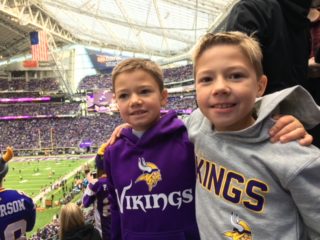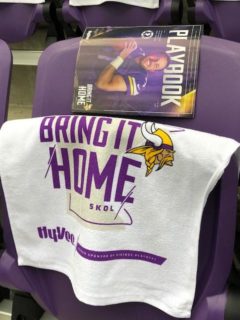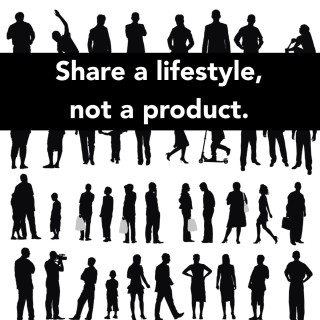I am a third-generation, dyed-in-the-wool Minnesota Vikings fan. I grew up with Vikings games playing at BOTH of my grandparents houses. My mom’s parents have a Vikings poster hanging in their upstairs hallway, which I always found incredibly hip of them! Dad took me and my sister to watch games when the Vikings were playing in Texas. My first date with my husband was watching the Vikings.
I’M A FAN.
 I have always expressed my loyalty for my beloved Vikings, so it’s no surprise that my husband and I attended Sunday’s divisional playoff game. And it was a game for the ages. The “Minneapolis Miracle” will go down in NFL lore. Despite seeing it in person, I have watched this video almost 50 times since Sunday, and it still makes my face explode in joy, pride and tears of pure happiness.
I have always expressed my loyalty for my beloved Vikings, so it’s no surprise that my husband and I attended Sunday’s divisional playoff game. And it was a game for the ages. The “Minneapolis Miracle” will go down in NFL lore. Despite seeing it in person, I have watched this video almost 50 times since Sunday, and it still makes my face explode in joy, pride and tears of pure happiness.
At this point, you might be wondering why a marketing agency blogger is waxing on about her beloved football team. I’ll tell you why. Branding. Look closely at the NFL. Every single team that plays in the NFL is a picture-perfect brand model.
Logo
The Minnesota Vikings logo is a depiction of, well, a Viking. It is unique, memorable, timeless, and versatile. And it clearly articulates their brand. As does the logo for the other 31 other teams. Play the logo game with your kids! My guess is that they can identify almost all teams by their logo alone (if they watch NFL football of course!).
Color Palette
Purple and gold are Vikings colors. The combination is unique and identifiable, and people can and do get behind it by wearing, painting, singing and displaying it. Give it extra points because it is Pantone’s color of the year.
Brand
 Each team is a subset of the bigger brand of the NFL, but form their own identity and personality. Every good brand should! Enter the Viking ship, the horn, the SKOL chant, Minnesota Nice, Purple Reign in honor of the late Prince, the desire and will to play their best, defend the north, and be warriors and at the same time the good guys.
Each team is a subset of the bigger brand of the NFL, but form their own identity and personality. Every good brand should! Enter the Viking ship, the horn, the SKOL chant, Minnesota Nice, Purple Reign in honor of the late Prince, the desire and will to play their best, defend the north, and be warriors and at the same time the good guys.
People
The coaching staff and the players all represent something bigger than their individual selves. They reflect, protect and represent the Vikings brand, on and off the field. People (employees past and present and consumers) are often overlooked as contributors to a brand. Don’t overlook this important piece of the puzzle.
Brand Advocates
This is me, this is the fan base, the former players, coaches, and owners. They proudly talk, share, and wear their team; and they stand by them through the rollercoaster of emotions that only elite sports brings. At Sunday’s game, past players such as Robert Smith, Chris Carter, Fran Tarkenton and John Randle pumped up the crowd and encouraged the current team from the sidelines – firing up an already explosive and LOUD crowd. Coach Mike Zimmer asked the stadium to be its loudest ever, and the fans delivered. My hoarse voice is proof.
A Vision
#bringithome is the post-season rally cry. US Bank will host Super Bowl LII and the Vikings have set the vision for their team and fans that they will bring it home. Check out this Bring It Home Feed on the Vikings homepage.
Recognize that in a digital storytelling era, a brand has the power to create an experience with its customer. This customer wants to be part of the story, as opposed to being told the story. This year the Vikings have masterfully brought their team, their fans and anyone that watches football into their story.
Sunday, January 14 at 7:11 p.m. will be The Biggest Moment In Vikings Franchise History for years to come. People will tell where they were, what they saw, and how they reacted … they will tell the story. And that is what branding is all about. The story. Not the product, service, outcome, or even the individuals.
It’s all about the story.
And that friends, is a very nice model to follow! We on the Porch would love to partner with you to share your story.
No matter what happens next for the Minnesota Vikings, this moment, the moment that made grown men and women cry, cannot be taken away. Ever. SKOL!

